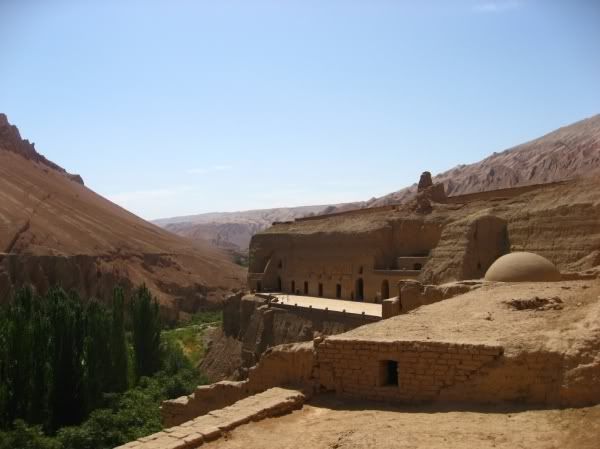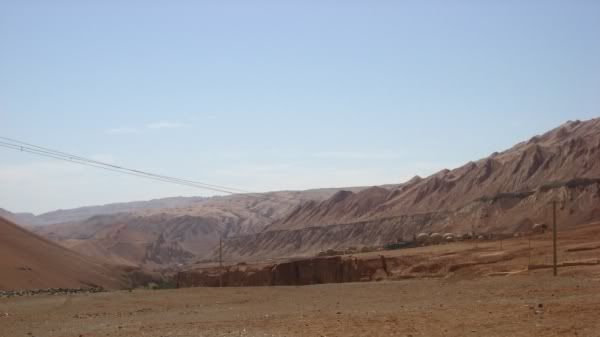Thursday, September 27, 2007
Turpan, part 2
Inspired by the South Korean who found my blog by searching for "yalu one step crossing", I found this important piece of news! "In the last two days China has erected a barbed-wire fence near the "one-step crossing" - where the Yalu river border is so narrow that you can almost leap across. " Which means: HAHA, suckers! I was the last one to get across the North Korean border! Anyway, back to Xinjiang...
Having procured breakfast, we headed back to the hotel to plan out our day. According to the guidebooks, most of the sights were actually located in a 45km radius around Turpan, rather than in the city itself. Both books suggested hiring a driver for the day and mentioned a lack of public transport, so we settled on a price of around 250 yuan with one of the many eager drivers around the hotel and set off in his dusty red Santana.

As we left Turpan, we passed the Flaming Mountains, famous for their mention in the travel records of Xuanzang, a Buddhist monk in the Tang dynasty who trekked all the way to India to obtain original Buddhist scriptures. Xuanzang’s route, starting in Xi’an at the Big Goose Pagoda, took him all the way up through Gansu, across Xinjiang, through what is now Kyrgyzstan, Uzbekistan, and Afghanistan, and finally down into India. “Journey to the West”, one of the four classic Chinese novels, was based on his travels, and several popular movies and TV series have been made about the book (which I’ve never read, but must get around to someday, considering someone manages to bring it up at least once any time I discuss Chinese books).

The Flaming Mountains are so-named because of their textured, “flamed” appearance and "reddish" color. They’re actually quite a long mountain range, so you can see them quite far out from Turpan from various sides. After driving across open desert for a while, we began driving through a valley, surrounded on both sides by the Flaming Mountains. Unfortunately, the car had darkly tinted windows, and the thing to roll the windows down was broken, so I didn’t get to take any pictures from the car.

Lonely Planet had talked down the Bezeklik caves, claiming it was “virtually empty”, but I wanted to go anyway – I remember watching a show on the Discovery channel years ago about Xuanzang’s travels, which featured footage of a beautiful Buddhist temple complex in a desert canyon. They didn’t bother mentioning the name of the place, but I thought it was one of those places so cool and faraway I’d never get to see it. But then I saw the picture in my Chinese guidebook and recognized it was the same place!

The Bezeklik cave complex was smaller than I thought, but it was still an impressive place. The caves were indeed a bit empty, as they had been plundered by Western “archaelogists”, and many of the faces on the Buddhist paintings had been rubbed off as idolatrous centuries ago by Muslims.

There were plenty of Korean tourists wearing facemasks for some reason. It can get dusty in Xinjiang, although not to the point where you'd need respiratory protection.


Nevertheless, there was still some interesting cave art to look at, and the place itself is quite visually stunning. Definitely worth a visit!
P.S. Am I the only one who thinks Blogger's default "large" image size is way too small? I had to upload my pics to Photobucket just to get the larger size you see on some of the pics here. Remember, you can always click on a picture to get the larger size.
To be continued…
Having procured breakfast, we headed back to the hotel to plan out our day. According to the guidebooks, most of the sights were actually located in a 45km radius around Turpan, rather than in the city itself. Both books suggested hiring a driver for the day and mentioned a lack of public transport, so we settled on a price of around 250 yuan with one of the many eager drivers around the hotel and set off in his dusty red Santana.

As we left Turpan, we passed the Flaming Mountains, famous for their mention in the travel records of Xuanzang, a Buddhist monk in the Tang dynasty who trekked all the way to India to obtain original Buddhist scriptures. Xuanzang’s route, starting in Xi’an at the Big Goose Pagoda, took him all the way up through Gansu, across Xinjiang, through what is now Kyrgyzstan, Uzbekistan, and Afghanistan, and finally down into India. “Journey to the West”, one of the four classic Chinese novels, was based on his travels, and several popular movies and TV series have been made about the book (which I’ve never read, but must get around to someday, considering someone manages to bring it up at least once any time I discuss Chinese books).

The Flaming Mountains are so-named because of their textured, “flamed” appearance and "reddish" color. They’re actually quite a long mountain range, so you can see them quite far out from Turpan from various sides. After driving across open desert for a while, we began driving through a valley, surrounded on both sides by the Flaming Mountains. Unfortunately, the car had darkly tinted windows, and the thing to roll the windows down was broken, so I didn’t get to take any pictures from the car.

Lonely Planet had talked down the Bezeklik caves, claiming it was “virtually empty”, but I wanted to go anyway – I remember watching a show on the Discovery channel years ago about Xuanzang’s travels, which featured footage of a beautiful Buddhist temple complex in a desert canyon. They didn’t bother mentioning the name of the place, but I thought it was one of those places so cool and faraway I’d never get to see it. But then I saw the picture in my Chinese guidebook and recognized it was the same place!

The Bezeklik cave complex was smaller than I thought, but it was still an impressive place. The caves were indeed a bit empty, as they had been plundered by Western “archaelogists”, and many of the faces on the Buddhist paintings had been rubbed off as idolatrous centuries ago by Muslims.

There were plenty of Korean tourists wearing facemasks for some reason. It can get dusty in Xinjiang, although not to the point where you'd need respiratory protection.


Nevertheless, there was still some interesting cave art to look at, and the place itself is quite visually stunning. Definitely worth a visit!
P.S. Am I the only one who thinks Blogger's default "large" image size is way too small? I had to upload my pics to Photobucket just to get the larger size you see on some of the pics here. Remember, you can always click on a picture to get the larger size.
To be continued…
Comments:
Post a Comment
